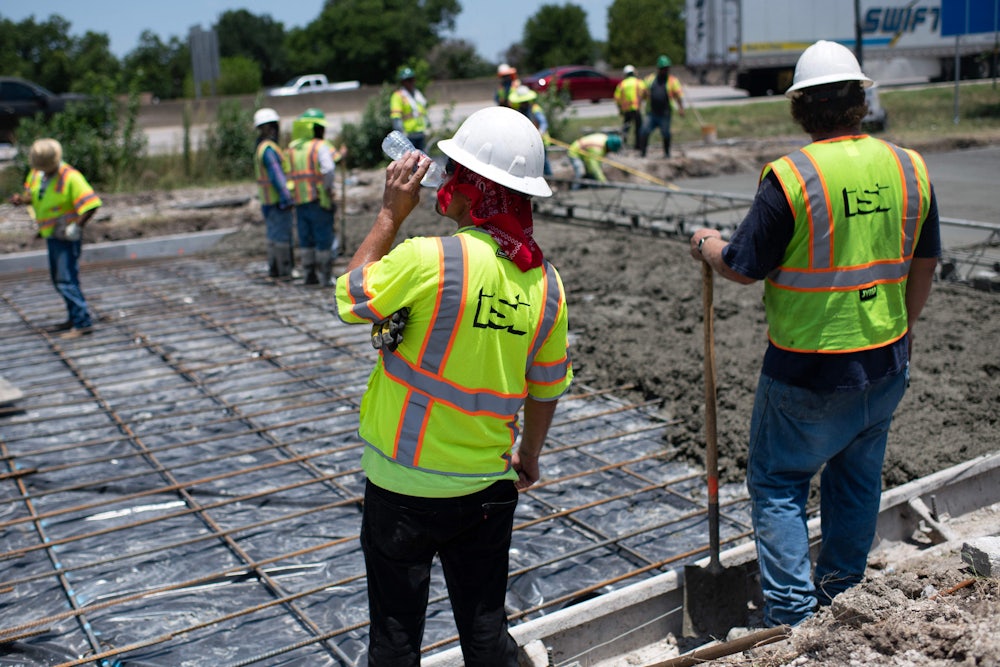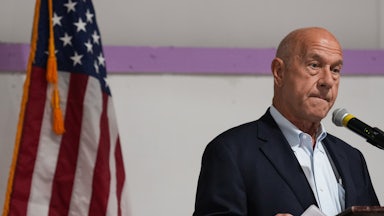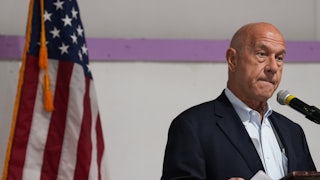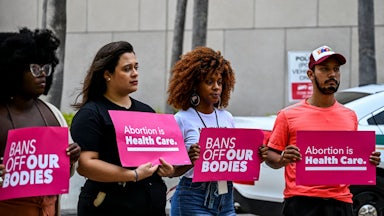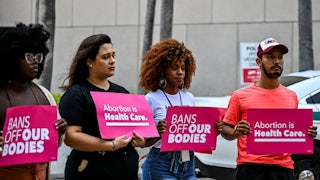The heat waves blanketing the South this week have had deadly results: At least 13 people have died in the sweltering temperatures in Texas. In Marshall, a 35-year-old utility lineman attempting to restore power to an area hit by storms was found on the floor of his motel room after a day of working outside; officials have attributed his death to heat-related causes. In Dallas, a USPS letter carrier collapsed while delivering mail as the heat index soared to 114 degrees. (An official cause of death for the letter carrier hasn’t been determined.)
Texas lawmakers, meanwhile, are going out of their way to get those numbers up. Republicans recently moved to strip away what few protections against extreme heat workers had in blue cities—and to keep more from being put in place. The same forces that worked to ensure something wasn’t done about climate change sooner will make living through it hell too.
A bill signed by Governor Greg Abbott earlier this month will overturn more than a century of home rule in Texas when it goes into effect on September 1, by concentrating decision-making in the GOP-controlled legislature. The breadth of what this bill, dubbed the “Death Star” bill, affects is enormous: everything from local ordinances on housing, agriculture, and payday lending, as well as local heat protections enacted at the city and county level. With federal protections for workers facing extreme heat still potentially years away, House Bill 2127 could have real health impacts on Texas workers as heat waves become more and more common.
“This bill is so broad and so far-reaching that I think it’ll be literally years before we see the full scope,” says Rick Levy, president of the Texas AFL-CIO. “It is a radical transfer of power from local communities to politicians in Austin.”
Like the heat waves sweeping over the South, H.B. 2127 (the “Texas Regulatory Consistency Act”) didn’t come out of nowhere. The law is a kind of Frankenstein monster, stitching together some of right-wing policymakers’ favorite tools. Many of those were sharpened by previous pushes to protect fossil fuel companies and snuff out climate measures. Among its backers are the Texas Public Policy Foundation, the fossil fuel–funded outfit that has helped spearhead a national push to prevent state fiduciaries from considering environmental, social, and governance, or ESG, factors in their decisions on where to invest public pension funds.
Like bills to preempt city bans on fracking and new gas hook-ups, the bill will not only prevent municipalities from establishing their own standards on a wide range of fronts—it will also wipe out those that already exist. Once it goes into effect on September 1, the law will overturn (among other things) ordinances in Austin and Dallas that mandate employers to provide 10-minute breaks every four hours, allowing construction workers to drink water and get out of the sun. The bill will be enforced in ways similar to Texas’s sweeping ban on abortion. Any individual or business claiming to be harmed by local ordinances can bring a suit against that government; attorneys’ fees are paid by the loser.
From the Koch brothers–backed American Legislative Exchange Council to the Texas Public Policy Foundation, fossil fuel money has long provided R&D funding for enterprising Republicans to fine-tune their quest for minority rule. H.B. 2127 is a gun clearly aimed, as well, at big, diverse, Democrat-controlled cities like Houston and Dallas. In a recorded call with former House Speaker Dennis Bonnen from 2019, H.B. 2127 sponsor Representative Dustin Burrows, of Lubbock, goaded on Bonnen, who bragged about having overseen the “worst session in the history of the legislature for cities and counties.” Burrows responded, “I hope next session is even worse,” before later saying, “We hate cities and counties.”
Burrows’s crusade against his fellow Texans could soon rack up a body count, leaving more workers exposed to dangerous heat. Official data from the Bureau of Labor Statistics show that 436 workers died from occupational heat stress between 2011 and 2020—about 40 per year. But that figure likely grossly underestimates the actual numbers. Unlike many other traumatic workplace injuries, like falling from a ladder, someone might succumb to heat-related illness hours after they’ve clocked out from work. Employers who self-report casualties may not count that as an occupational death. Doctors might not make the connection, either. Up to 170,000 workers each year deal with heat-related injuries. A 2021 meta-analysis of studies on occupational injuries across different climactic zones found that such injuries increase by 1 percent for every one degree Celsius of warming.
“Even though those are things that are the result of heat stress or are the result of the heat the body was not able to cool down from, it doesn’t always get recorded that way,” said Juley Fulcher, worker health and safety advocate with Public Citizen and the author of a recent report on heat-related workplace deaths. “When doctors and coroners are writing a death certificate and they put down the cause of death, they point to something like heart failure or kidney failure. Even though those are things that are the result of heat stress or are the result of the heat the body was not able to cool down from, it doesn’t always get recorded that way.”
A previous report by Fulcher—cross-referencing population fatality data with location-specific temperature data—found that as many as 2,000 workers die from heat-related illness every year in the United States, which would make it among the country’s top three causes of occupational fatalities. Most at risk are farm and construction workers, who have the highest rates of heat-related deaths. Black construction workers are 51 percent more likely to die from heat-related causes, while Mexican-born workers are 91 percent more likely. Undocumented workers face further threats still.
“It’s the most vulnerable workers who typically are going to be most at risk,” Levy said. “What this law does is take another tool away from them to at least be able to say, ‘We deserve a break.’”
Protections against heat can be written into the collective bargaining agreements unions negotiate with their employees. UPS Teamsters won a company-wide commitment late last month to provide air conditioning and other cooling measures in delivery vans where temperatures can reach well into the triple digits on hot days. After the death of the letter carrier in Dallas, National Association of Letter Carriers Branch 132 announced this week that postal workers would start work earlier to avoid record-breaking midday heat. But Texas has one of the lowest rates of unionization in the country. The continued lack of federal standards regarding sky-high temperatures means that workers who haven’t explicitly negotiated heat protections into their contracts have little recourse. Those without any sort of union representation have to fend for themselves.
There is no explicit legal requirement for employers to protect employees from heat-related workplace dangers. The Biden administration is currently in the process of developing the country’s first-ever explicit protections and standards regarding extreme heat through the Occupational Safety and Health Administration, but any final rule is at least a year away. In the meantime, those looking to hold employers accountable have to lean on the General Duty Clause of the Occupational Safety and Health Act. The track record for doing so is mixed, at best. As Fulcher notes in her report, OSHA has repeatedly cited the USPS for exposing its workers to unmitigated excessive heat while they deliver mail. In five separate cases, judges with OSHA’s administrative court overturned the citations, ruling that the agency had failed to prove workplace conditions—including 109 degree heat indexes and medical diagnoses of heat stress—were hazardous.
Public Citizen has advocated for Congress to pass the Asuncíon Valdivia Heat Illness, Injury and Fatality Prevention Act, which would direct OSHA to create an interim heat standard until a permanent rule is finalized. Though OSHA could theoretically do such a thing on its own, it’s likely to be tied up in the courts by business interests who oppose it. Having a mandate from Congress could insulate from those challenges, although the right may well take legal action in any case.
As Levy explained, city-level protections like those passed in Austin and Dallas were the result of years of work by unions and community groups looking to fill the gaps left at the state and federal level. “It’s not like cities and counties wanted to just do this. There was a lot of organizing behind it,” he told me. “If you can’t gain protections from the state and now you can’t gain protection from localities, organizing a union is a no-brainer for trying to do something that can really protect lives.”
Like other policy fights birthed in Texas and exported to state legislatures around the country—including the right’s crusade against all things ESG—H.B. 2127 may not be the last bill of its kind.
“We unfortunately have become a little bit of a launching pad of far-right ideological, corporate-led campaigns,” Levy added. “Historically, what happens in Texas doesn’t stay in Texas.”
